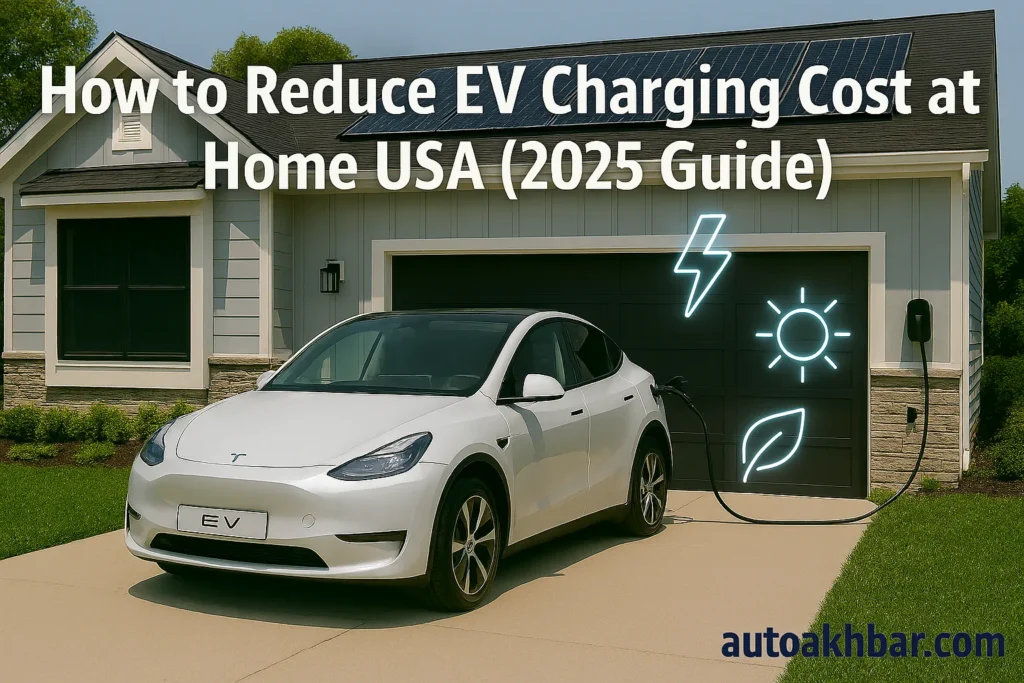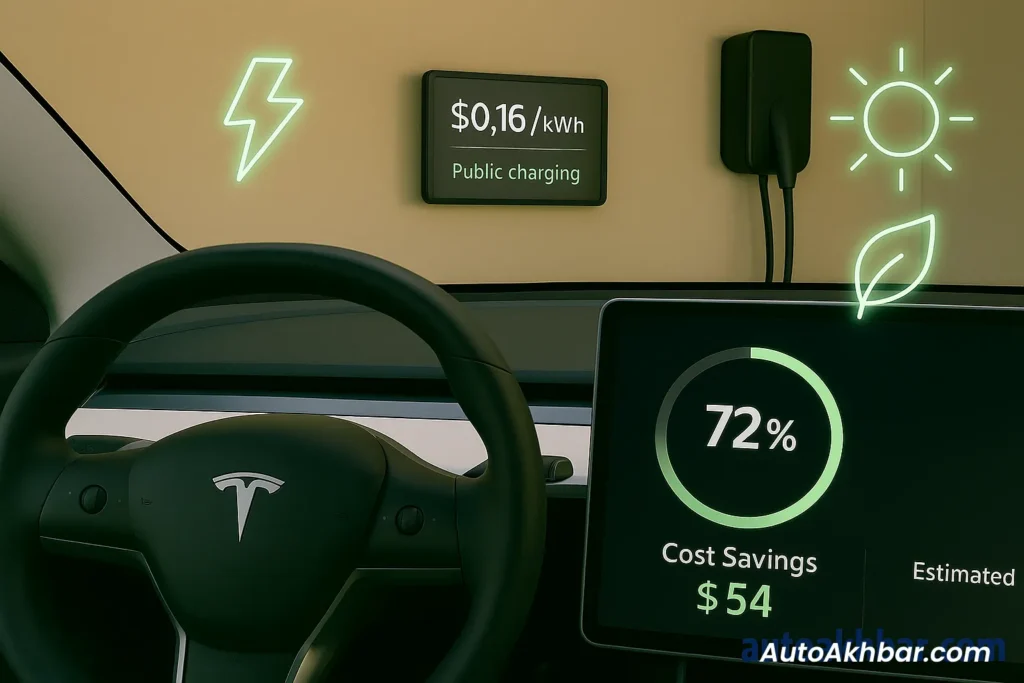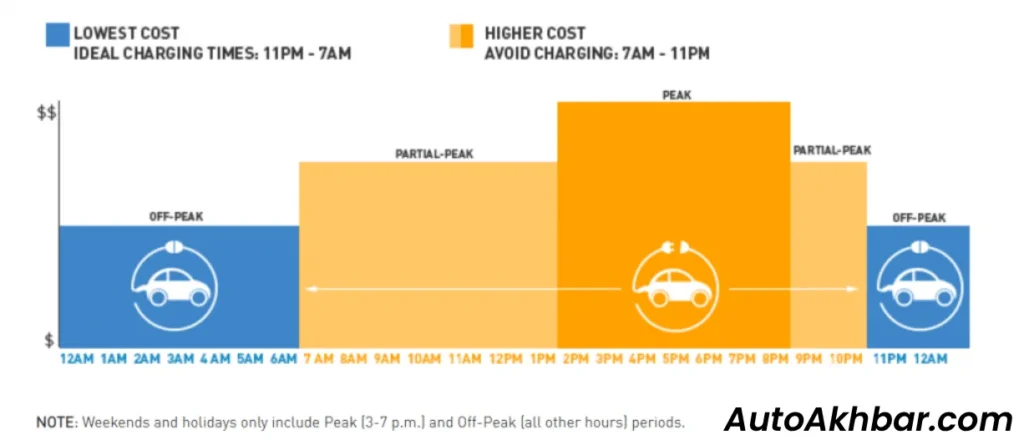How to Save on At-Home Electric Car Charging Costs
Introduction: Why This Matters
If you own an electric car in the USA, chances are you’ve already asked yourself: “How much does it really cost to charge at home—and how do I keep that bill low?” With gas prices still hovering around $3.50 per gallon and electricity rates varying by state, the way you charge can make or break your savings.
At AutoAkhbar.com, we’ve broken it down into simple, real-world tips that anyone can use—no technical jargon, no complicated math. Just practical advice to help you reduce your EV charging cost at home in the USA.

Table of Contents
1. Understand Your Home Electricity Rate
The average U.S. electricity rate is about $0.16 per kWh. That means an EV using around 11.8 kWh per day costs less than $2 a day to charge at home. Sounds cheap, right? But it adds up—roughly $56 a month.
👉 Tip: Check with your local utility if they offer time-of-use (TOU) rates, where charging at night can drop the price to $0.10 per kWh or less.
2. Charge Overnight to Take Advantage of Off-Peak Rates
Most American utilities charge less when the grid is quiet—typically after 9 PM until early morning. Since 90% of EV owners already charge overnight, you’re in good company.
👉 Tip: Set your EV’s charging timer (most EVs have this built-in) to automatically start charging at off-peak hours.

3. Choose the Right Charger for Your Needs
- Level 1 Charger (120V): Plugs into a standard outlet. Slower (2–5 miles of range per hour), but cheapest to install.
- Level 2 Charger (240V): Faster (10–60 miles of range per hour) but requires professional installation. Costs $250–$800 for the outlet plus charger price.
👉 Tip: If you drive fewer than 30 miles daily, a Level 1 charger is often enough and costs nothing extra beyond your normal electricity bill.
4. Be Smart With Charging Habits
One of the most common mistakes EV owners make is charging to 100% every night. Just like you didn’t fill up your gas tank daily, you don’t need to “top up” your EV every night either.
👉 Tip: Keep your charge between 20–80% for daily use. It’s cheaper, healthier for your battery, and reduces unnecessary electricity use.
5. Consider Solar Power for Long-Term Savings
If you live in a sunny state like California, Texas, or Arizona, adding solar panels can bring your home charging cost close to $0 per kWh. Plus, you may qualify for federal tax credits that offset installation costs.
👉 Tip: Pair solar with a home battery storage system to charge your EV even when the sun isn’t shining.

6. Use Smart Charging Technology
Modern EV chargers and apps let you:
- Schedule charging during low-cost hours
- Monitor electricity usage in real-time
- Avoid demand charges that spike during peak usage
👉 Tip: If your utility uses demand charges, spreading charging sessions instead of doing one huge overnight charge can reduce costs.
7. Compare Utility Plans and Incentives
Some U.S. states and utility providers offer special EV-only plans. For example:
- PG&E (California): Discounted EV charging at night.
- Duke Energy (Florida, North Carolina): Rebates for installing home chargers.
- Con Edison (New York): Incentives for off-peak charging.
👉 Tip: Call your provider and ask specifically: “Do you offer EV charging rates or rebates?”
8. Keep an Eye on Federal and State Tax Credits
Did you know the IRS tax credit for EVs can nearly cover the cost of a home charger and installation? In 2025, the minimum credit is often higher than the typical installation expense. That’s free money you don’t want to leave on the table.
Conclusion: Small Tweaks, Big Savings
Charging an EV at home in the USA is already cheaper than filling up a gas car, but with the right strategy, you can save even more. From off-peak charging and smart chargers to solar power and utility rebates, every little tweak adds up.
💡 Final thought: Instead of stressing about nightly charging or high street charger costs, focus on weekly smart charging at home. It’s simple, affordable, and keeps your EV road-ready without draining your wallet.
FAQ How to Reduce EV Charging Cost at Home USA
How much does it cost to charge an electric car at home in the USA?
On average, charging an EV at home costs around $0.16 per kWh, which equals about $56 per month, much cheaper than gasoline.
Is charging an EV at home cheaper than public charging stations?
Yes, home charging is more cost-effective. Public stations cost $0.30–$0.60 per kWh, while home rates average only $0.16 per kWh.
What is the installation cost of a Level 2 home EV charger in the USA?
Installing a Level 2 charger typically costs between $250–$800 depending on electrician fees and equipment.
Does charging an EV overnight save money?
Yes, many utilities offer off-peak night rates, making overnight charging the cheapest option for EV owners.
Can I use solar panels to charge my EV at home?
Absolutely. Using solar power can cut your electricity bills and may qualify you for tax credits or rebates in the USA.


